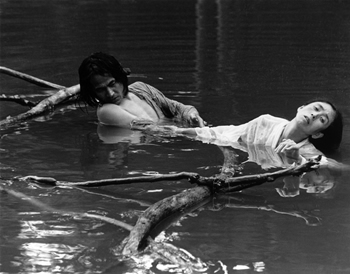Tuesday night, 300 extremely lucky people gazed in wonder from the slope above as the Japanese-born dancers Eiko and Koma recreated their very beautiful dance, The River, in the large pond in Duke Gardens’s Asiatic garden, in the first of their only two performances in this American Dance Festival season. Although the pair originally made this dance in 1995 to occur in running water, they have long since successfully adapted it to work in a pond or lake. (They performed it first in Duke Gardens in 1996.) The sense of flow they create with their bodies is so strong that you can almost feel the current moving over your own skin.
Eiko and Koma move very slowly — very, very slowly — evading nothing, encompassing everything, connecting their pale vulnerable bodies to feelings difficult and joyous, to ideas and philosophies, and to the elemental, sensual world. Although they grew out of Japanese modern dance, studying with the founders and masters of butoh before going on to study European modern dance, their work is, in my experience, unique. Many viewers of more active, more easily beautiful dance will find this work difficult or off-putting, but for those who can sit quietly and watch intently, any dance by Eiko and Koma offers enormous sustenance, and perhaps even a kind of enlightenment. Here I must confess to being an ardent fan of Eiko and Koma’s work, which I saw for the first time during their first time at ADF, in 1983. I have seen them at their every appearance here since, and watched their bodies change with the years, and the dances change with the bodies. No one can replicate their bodies’ work, and I am finding it difficult knowing that those bodies cannot go on forever.
They know it, too, and are in the midst of a comprehensive retrospective project, which includes not only the re-creation of dances, but a book, museum installations and a revamped, high-quality website with good video. Images are good; but they are the residue only of the bodies’ lifework. Nothing can replace being near those bodies as they move, corporeal, yet shadowlike; themselves and ghosts of themselves. If you can, give yourself that experience. The June 6 performance of The River is likely to be the last one given here.
That we can experience this particular miracle of artistic communication, and many others of Eiko and Koma’s, is partially thanks to their lighting designer, David Ferri. The advances in lighting (and video) technology since 1996 have made this dance in the dark even more wonderful than it was 15 years ago. The audio quality for Somei Satoh’s recorded score is also so remarkably good that the plucked strings seem to reverberate from right behind you before shimmering their sound across the water.
Arrive early, settle yourself near the pond. Let dusk mantle you. Enjoy the natural chorus, the bats in weightless flight, the great heron’s raucous cry as he beats wide wings over the pond. Unusual swans, black-headed like the dancers, with gleaming white bodies, glide over its surface, presaging the dance. In the pond, a white sail-like construction rises motionless from the water. Koma holds it, standing so still you may not notice him. On the far side, fire blazes beneath the stone lantern near the arching red bridge. A pale mound with a dark knob doubles the form of stone. It is Eiko.
Darkness falls, and reflections appear on the mirroring surface of the pond. So slowly that he does not ripple the sail’s reflection, Koma begins to move. The sail becomes a screen, accepting (beautifully shot and edited) dreamlike video of the two dancers in water. The “boat” capsizes, the white screen submerges; Koma’s white face floats away downstream. Eiko unfolds and drips into the water, rock liquefying beside the reflected flame and inverted image of the stone lantern. She wears a thin white robe; turning her shoulder, she brings back the shape of the sail. Slowly, slowly, she moves toward the center of the pond, folding and turning and arching, making the images just seen on video. Her hands and wrists, the angle of her neck, the dripping sleeve so white in the darkness — all are so beautiful you may cry.
Koma reappears from an unexpected direction, just when it had seemed that Eiko was the last soul in the world. He’s pushing the “boat,” an open construction of rough sticks. During a protracted section, they reach each other, lose each other, reach again. Tenderly, gently, they assist each other in and out of the drifting boat. As it floats them away into the dark, their white faces doubled on the water, you may feel a surge of gratitude that life passes such miracles before you before it takes them past your ken.
The River repeats June 6 only in Duke Gardens. The official start time is 9:15, but it really begins when “the house” opens at 8:45. Seating is limited. See sidebar for details, and call for ticket availability.











